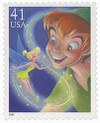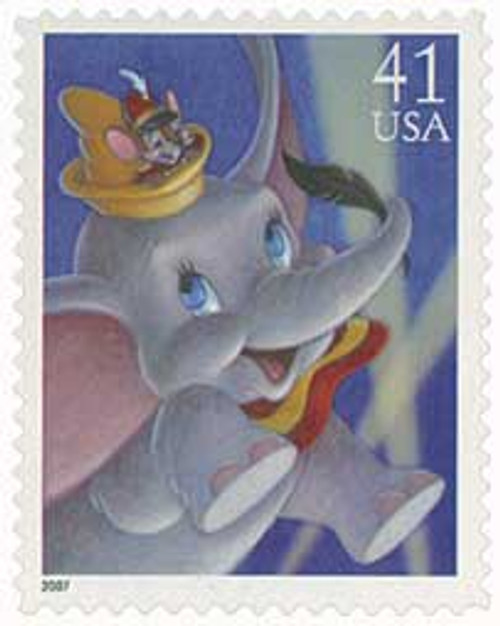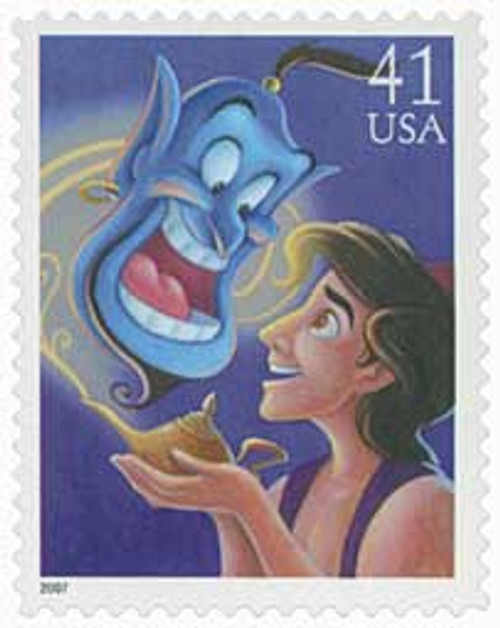
# 4193 - 2007 41c The Art of Disney, Magic: Peter Pan and Tinker Bell
Art of Disney– Magic
City: Orlando, FL
Quantity: 200,00,000
Happy Birthday J.M. Barrie
Barrie was the ninth of ten children. When he was six, one of his brothers died. Though his mother was devastated by the loss, she was comforted by the fact that he would remain a boy forever and never grow up and leave her. This likely served as one of Barrie’s inspirations for his most famous work many years later.
As a child, Barrie was an avid reader, enjoying such books as Robinson Crusoe and the Pilgrim’s Progress, as well as works written by Robert Michael Ballantyne and James Fenimore Cooper. He knew from a young age that he wanted to be a writer, though his family hoped he’d choose a profession, particularly the ministry. He agreed to attend a university but only to study literature.
After graduating from the University of Edinburgh, Barrie worked in advertising and then as a journalist for the Nottingham Journal. He then sent a piece to the St. James’s Gazette, based on stories from his mother’s hometown. The editor of the London newspaper liked the Scottish feel of the story and hired Barrie to write several more. These formed the basis of his first novels – Auld Licht Idylls (1888), A Window in Thrums (1890), and The Little Minister (1891).

Barrie received moderate success from the publishing of these stories, leading him to continue writing as a career. After publishing few more books, he turned his attention to the theater, writing a string of successful plays.
Then in 1897, Barrie met the Llewelyn Davies family. They were neighbors he met while walking his Saint Bernard Porthos. He soon befriended the family’s three sons, George, Jack, and baby Peter. Barrie frequently entertained them with his stories. One of the most popular was about their baby brother Peter. Barrie told the boys that babies were birds before they were born and that parents put bars on nursery windows so they wouldn’t fly away. But Peter was a special boy and flew away. In later years, when the boys’ parents passed away, Barrie became their trustee and guardian, providing financial support whenever possible.
Barrie was captivated by his new character and included him in The Little White Bird in 1902. Two years later, he premiered the play Peter Pan, or the Boy Who Wouldn’t Grow Up in London. It was immensely popular. Following the play’s success, Barrie adapted the story into a novel, Peter and Wendy, in 1911. The play and novel helped to popularize the name Wendy in the United Kingdom.

Barrie continued to write successful novels and plays after Peter Pan. Many addressed social issues and another returned to the idea of an ageless child. Barrie’s final play, The Boy David, dramatized the Biblical story of King Saul and young David.
Barrie died on June 19, 1937. He gave London’s Great Ormond Street Hospital for Children the rights to Peter Pan, allowing them to benefit from the story’s success for years to come.
Art of Disney– Magic
City: Orlando, FL
Quantity: 200,00,000
Happy Birthday J.M. Barrie
Barrie was the ninth of ten children. When he was six, one of his brothers died. Though his mother was devastated by the loss, she was comforted by the fact that he would remain a boy forever and never grow up and leave her. This likely served as one of Barrie’s inspirations for his most famous work many years later.
As a child, Barrie was an avid reader, enjoying such books as Robinson Crusoe and the Pilgrim’s Progress, as well as works written by Robert Michael Ballantyne and James Fenimore Cooper. He knew from a young age that he wanted to be a writer, though his family hoped he’d choose a profession, particularly the ministry. He agreed to attend a university but only to study literature.
After graduating from the University of Edinburgh, Barrie worked in advertising and then as a journalist for the Nottingham Journal. He then sent a piece to the St. James’s Gazette, based on stories from his mother’s hometown. The editor of the London newspaper liked the Scottish feel of the story and hired Barrie to write several more. These formed the basis of his first novels – Auld Licht Idylls (1888), A Window in Thrums (1890), and The Little Minister (1891).

Barrie received moderate success from the publishing of these stories, leading him to continue writing as a career. After publishing few more books, he turned his attention to the theater, writing a string of successful plays.
Then in 1897, Barrie met the Llewelyn Davies family. They were neighbors he met while walking his Saint Bernard Porthos. He soon befriended the family’s three sons, George, Jack, and baby Peter. Barrie frequently entertained them with his stories. One of the most popular was about their baby brother Peter. Barrie told the boys that babies were birds before they were born and that parents put bars on nursery windows so they wouldn’t fly away. But Peter was a special boy and flew away. In later years, when the boys’ parents passed away, Barrie became their trustee and guardian, providing financial support whenever possible.
Barrie was captivated by his new character and included him in The Little White Bird in 1902. Two years later, he premiered the play Peter Pan, or the Boy Who Wouldn’t Grow Up in London. It was immensely popular. Following the play’s success, Barrie adapted the story into a novel, Peter and Wendy, in 1911. The play and novel helped to popularize the name Wendy in the United Kingdom.

Barrie continued to write successful novels and plays after Peter Pan. Many addressed social issues and another returned to the idea of an ageless child. Barrie’s final play, The Boy David, dramatized the Biblical story of King Saul and young David.
Barrie died on June 19, 1937. He gave London’s Great Ormond Street Hospital for Children the rights to Peter Pan, allowing them to benefit from the story’s success for years to come.












